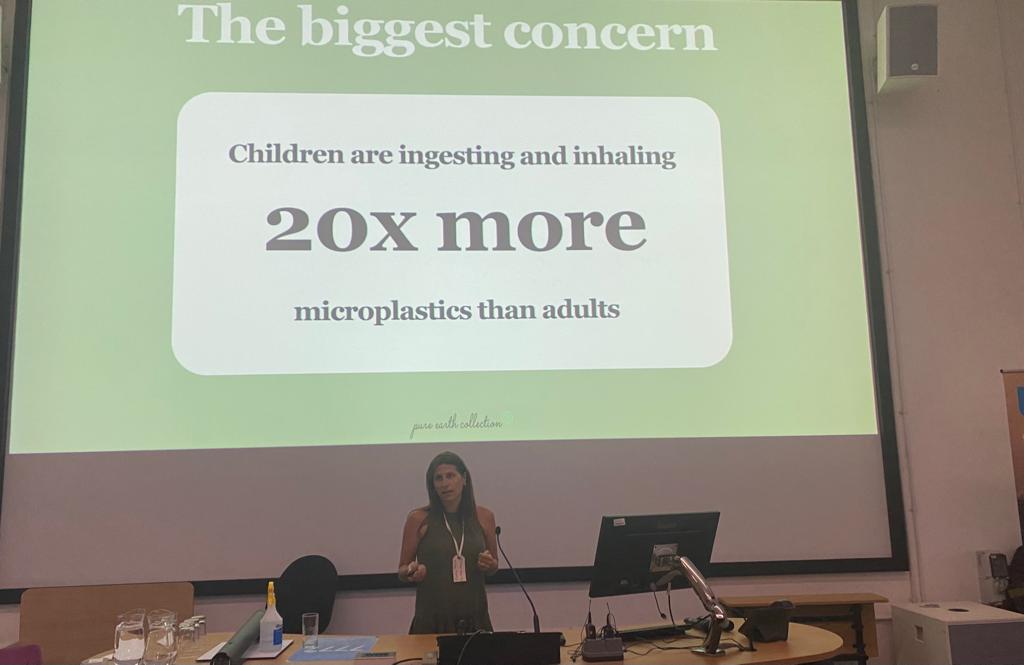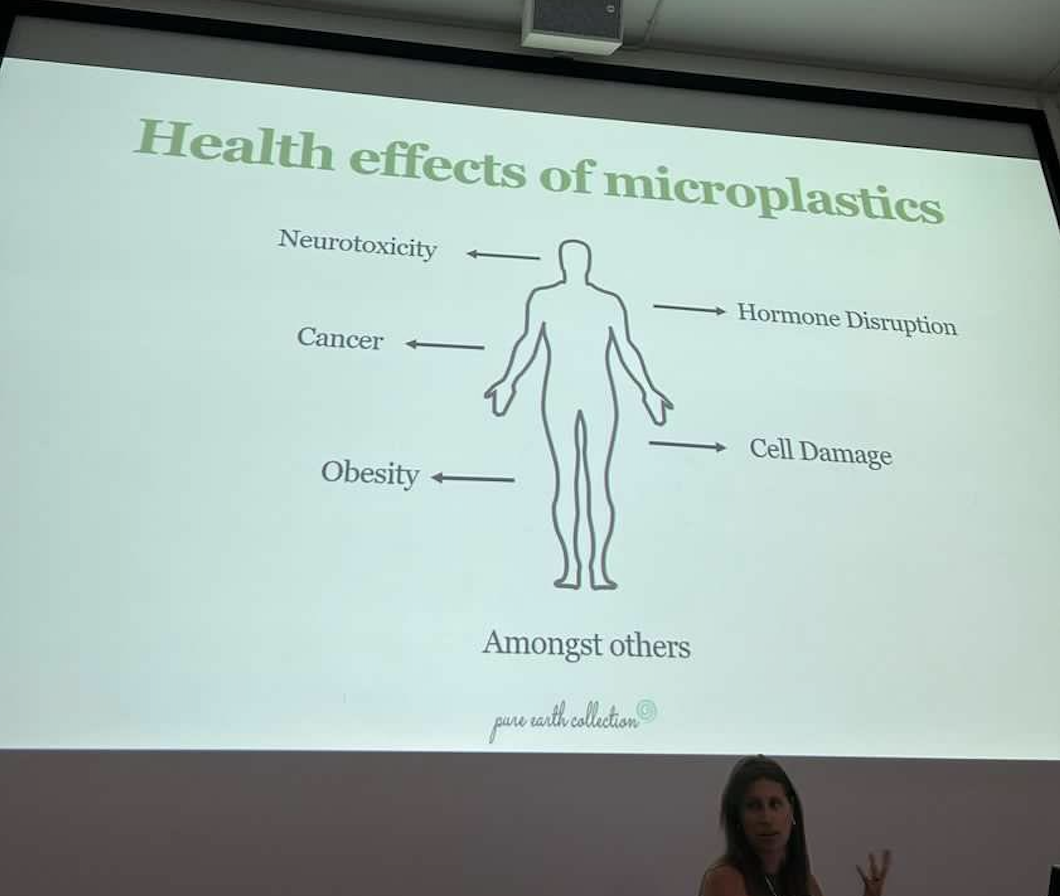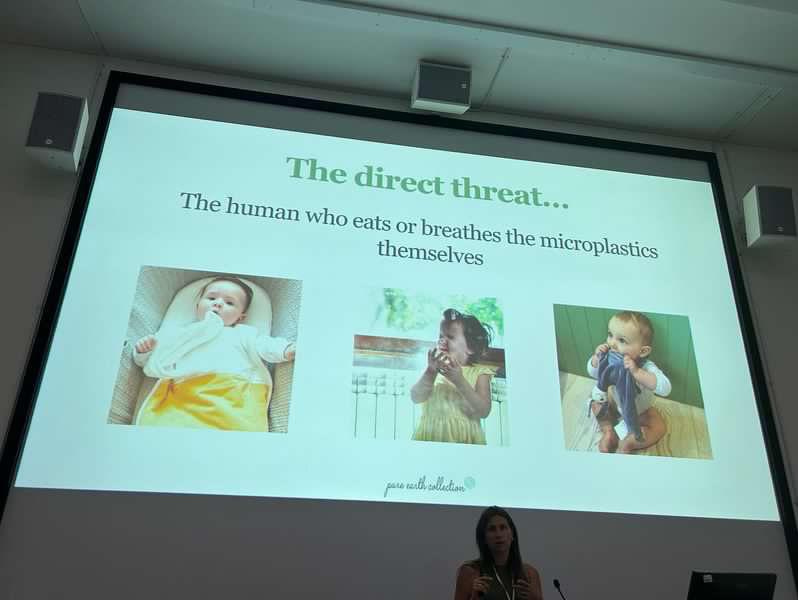
It’s now well known that microplastics inside the human body are a huge health concern. Once inside our bodies, they start to break down, releasing chemicals into our organs and bloodstream. Microplastics inside the human body are linked to cancer, hormone disruption, neurotoxicity, cell damage, obesity, reproductive issues and more.



As a thought leader on this topic, last month I was invited to speak at the Plastics Future conference in Portsmouth. A conference which brought together leading professors, policymakers, private sector individuals and others from all over the world to discuss the growing urgency of the microplastic catastrophe – both to the environment and to human health. Below is a summary of what was discussed and why this issue is growing in urgency.
Studies have shown that polyester microfibres are the single biggest contributor to microplastic contamination in our homes, environment and inside the human body.
Is polyester a microplastic?
Polyester is classed as a ‘primary microplastic’ due to the rate at which it sheds microfibres when worn, touched or washed. Polyester sheds more microplastics than any other material, making up nearly three-quarters of microplastic pollution in the Arctic and two-thirds of the microplastics in household dust *. When these microfibres are released into the air they cause worrying levels of microplastic air pollution which is then breathed in, getting lodged deep inside our lungs. It also sheds microplastics directly into the mouths of small children when it’s sucked on, as well as the nanoplastics being small enough to be absorbed through the skin when in direct contact with the body.
Polyester has been linked to miscarriages in women and was found to be a totally effective form of contraception for men, with polyester underpants decreasing sperm count and reducing the size of genitals in 100% of men in the test groups*.
Yet sadly, over 95% of all soft toys sold globally are made from this chemical-laden, microplastic shedding fabric which is causing havoc to human health.
Let’s take a look at how microplastics enter the human body:
- Inhalation: Via the air that we breathe. For an interesting visual on this, you can watch our short video here.
- Ingestion: Directly swallowing these particles.
- Dermal contact: The chemicals, as well as the nanoplastics, get absorbed through the skin directly into the bloodstream.

Is recycled polyester safer?
Sadly not! Recent studies have shown that RECYCLED POLYESTER CONTAINS HIGER LEVELS OF DANGEROUS CHEMICALS THAN VIRGIN POLYESTER *.
With mounting health concerns about babies ingesting millions of microplastics from polyester teddies, fabrics and soft furnishings, it’s extremely concerning that studies have now found that recycled polyester contains even more toxic chemicals than virgin polyester.
There are over 13,000 chemicals used to make plastic. The process of recycling involves heating plastics at high temperatures, which releases many of these chemicals. This, plus contamination from other forms of plastic along the recycling journey makes the findings extremely concerning.
In particular, benzene (a known carcinogen) can be created when recycling PET plastics (the plastic type used to make polyester). BPA, another known carcinogen and hormone disruptor, has also been found in polyester fabrics in recent studies.
How easy is it to cut down our family’s microplastic exposure?
So here’s the good news: The vast majority of children’s microplastic exposure happens in their own homes and schools. This means there is SO much we as caregivers can do to cut down their intake of these toxins. Our number one tip is to avoid polyester and synthetic textiles as much as you possibly can. Where it’s not avoidable, limit your children’s exposure to those fabrics by keeping them out of reach of little ones, not wearing synthetic materials when you’re looking after the kids and covering up play areas on synthetic carpets with a natural fabric area rug.
Pure Earth Collection are passionate about cutting out the plastics in kids’ lives. You can check out our multi-award-winning range of plastic-free children’s products here.
For more information and easy tips on how to reduce your family’s exposure to these toxins, you can check out our PlasticFreeBabies campaign here.
Sources:
According to the National Institute of Health

New Scientisthttps://www.newscientist.com › article › 2264585-mic…
12 Jan 2021 — Polyester fibres make up nearly three-quarters of microplastic pollution in the Arctic and probably come from textile manufacturing and …
https://www.sciencedirect.com/science/article/pii/S016041201931952X#e0005
Source: Forever Toxic: The science of health threats from plastic recycling. Greenpeace
